Sol'Ex configurations for ultra narrowband filter measurements
Sol'Ex V1 configuration (with 125 mm f.l. collimator, 125 mm f.l. imager and ASI290). Right image : rugerized version.
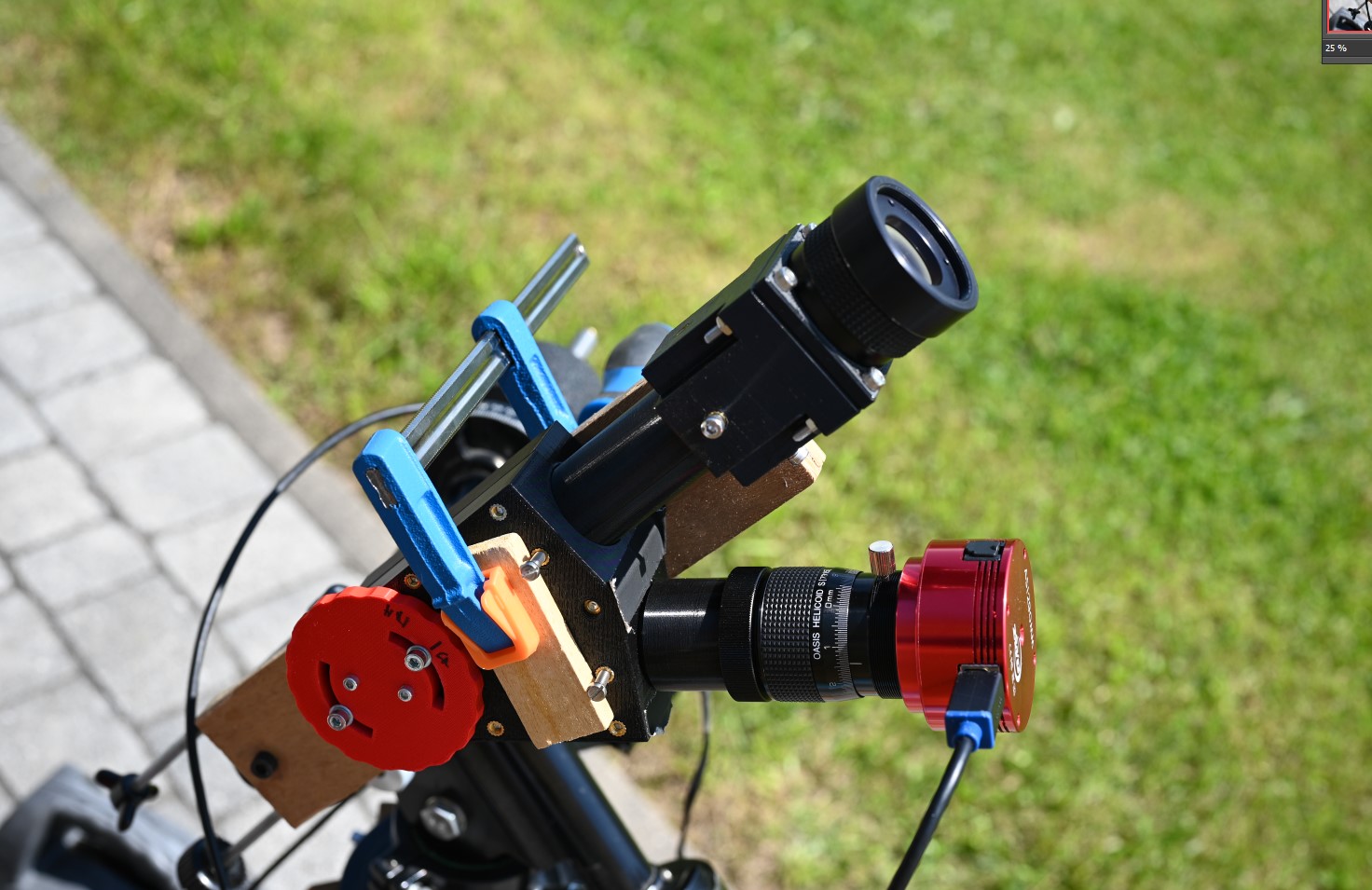

Sol'Ex V2 configuration : with
200 mm f.l. collimator, 200 mm f.l. imager and ASI290. Note the M42 focusing ring
on the collimator tube.
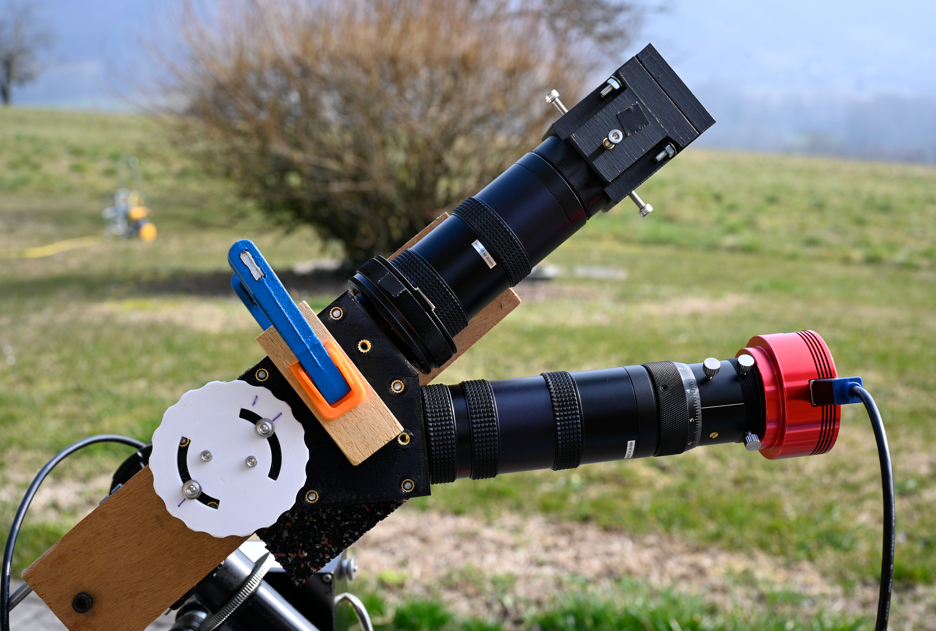
Dispersion and resolving power
| Configuration |
Dispersion near Ca II |
Dispersion near Ha |
Resolving power near Ca II |
Resolving power near Ha |
| V0 : 80 mm f.l. collimator + 2400 l/m grating + 125 f.l. mm imaging lens + ASI 290 |
0.093 A/px |
0.075 A/px |
|
|
| 125 mm f.l. collimator + 1200 l/m grating + 125 f.l. mm imaging lens + ASI 290 |
0.0193 A/px |
0.0192 A/px |
|
|
| V1 : 125 mm f.l. collimator + 2400 l/m grating + 125 f.l. mm imaging lens + ASI 290 |
0.0933 A/px |
0.0757 A/px |
|
|
| V2 : 200 mm f.l. collimator + 2400 l/m grating + 200 f.l. mm imaging lens + ASI 290 |
0.0582 A/px (measured) |
0.0471 A/px (measured) |
0.18 A (measured) |
0.17 A (measured) |
Evaluation of spectral resolution using fine lines of the solar spectrum
125 mm collimator: Sol'Ex V1 configuration (10 micron slit, 125 mm f.l. collimating lens, 2400 l/mm grating, 125 mm f.l. imaging lens, ASI290)
The actual FWHM of the Fe 1 line at 6546.27 A is about 0.1 A FWHM (see solar spectrum compiled by J.M. Malherbe from Delbouille and al.).
The FWHM measured with Sol'Ex (Lorentzian curve fitting) is about
3.9 × 0.0757 = 0.30 A, which is probably a good proxy for the spectral
resolution of this configuration near Ha.

200 mm collimator: Sol'Ex V2 configuration (10 micron slit, 200 mm f.l. collimating lens, 2400 l/mm grating, 200 mm f.l. imaging lens, ASI290)
Spectral resolution near Ha : the FWHM of the labelled ATM H
2O line was measured at 0.18 A (curve fitting with Voigt function).
Between Ca K and H : FWHM of 0.17 A for the finest lines.
Both figures are comparable to the theoritical spectral resolution of
Sol'Ex assuming a 5 micron FWHM for the 200 mm f.l. collimating lens.
Ca II K and H lines
Sol'Ex V2 configuration: 10 micron slit, 200 mm f.l. collimating lens, 2400 l/mm grating, 200 mm f.l. imaging lens, ASI290:

Solar limb taken with the Takahashi TOA150 and Sol'Ex V2. Visible
beyond the photospheric limb are Ca K3(absorption), Ca K2r and v
(emisison), Ca H3 (absorption), H2r and v (emission), and H
epsilon lines:

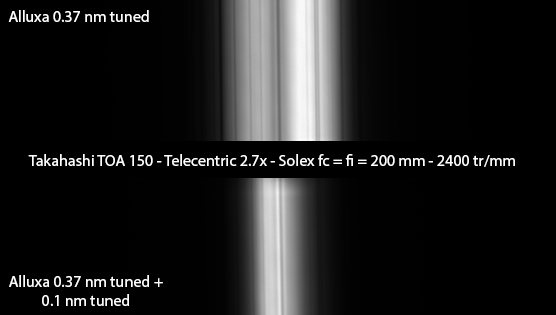
Sol'Ex V1 configuration: 10 micron slit, 125 mm f.l. collimating lens, 2400 l/mm grating, 125 mm f.l. imaging lens, ASI290:
Top image : reference very high resolution solar spectrum with lines labelled. Bottom : spectrum obtained with Sol'Ex.

G-band
Sol'Ex V2 configuration: 10 micron slit, 200 mm f.l. collimating lens, 2400 l/mm grating, 200 mm f.l. imaging lens, ASI290:

Sol'Ex V0 configuration: 10 micron slit, 80 mm f.l. collimating lens, 2400 l/mm grating, 125 mm f.l. imaging lens, ASI290: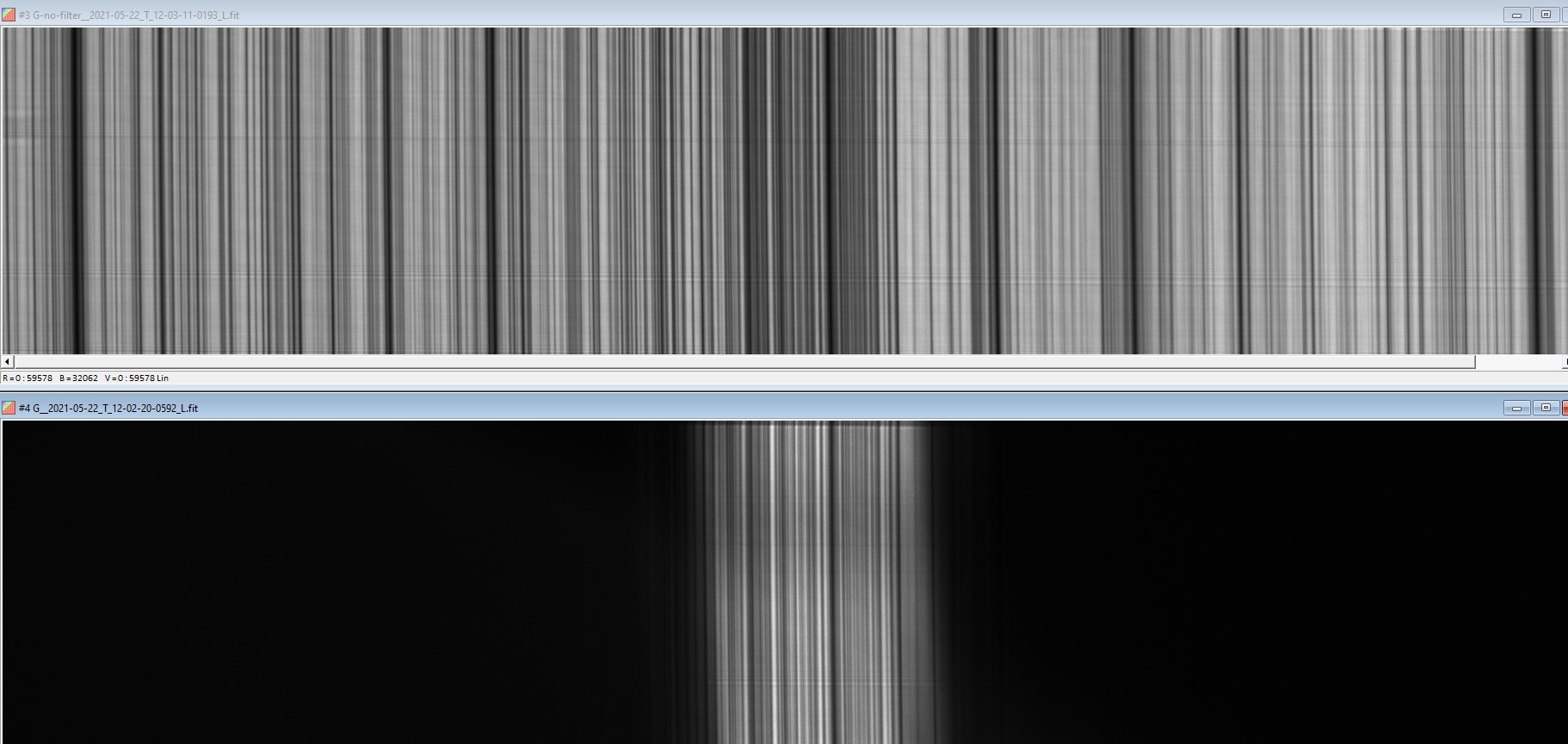
Mg triplet
Sol'Ex V2: configuration: 10 micron slit, 200 mm f.l. collimating lens, 2400 l/mm grating, 200 mm f.l. imaging lens, ASI290:

Sol'Ex V0: configuration: 10 micron slit, 80 mm f.l. collimating lens, 2400 l/mm grating, 125 mm f.l. imaging lens, ASI290:

Na doublet
Sol'Ex configuration: 10 micron slit, 80 mm f.l. collimating lens, 2400 l/mm grating, 125 mm f.l. imaging lens, ASI290:
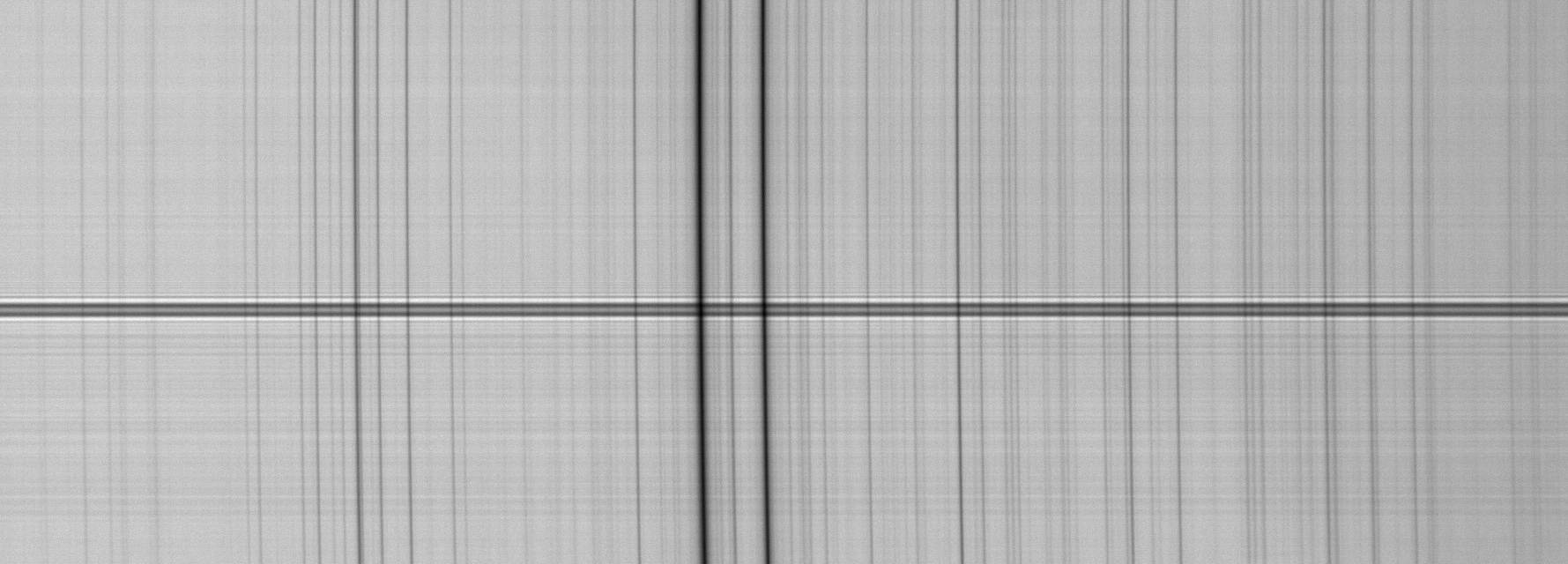
Ha line
Sol'Ex V2 configuration: 10 micron slit, 200 mm f.l. collimating lens, 2400 l/mm grating, 200 mm f.l. imaging lens, ASI290:

Sol'Ex V0 configuration: 10 micron slit, 80 mm f.l. collimating lens, 2400 l/mm grating, 125 mm f.l. imaging lens, ASI290:
Mesurement of the linewidth of the Ha line of an hydrogen spectral lamp
One method to measure the FWHM of
F-P etalon is to use an hydrogen spectral lamp. Accordingly, it is
relevant to know how large is the linewidth of the Ha line provided by the
spectral lamp. Three measurements were done with Sol'Ex versions of increasing spectral resolution.
1) 80 mm collimator: Sol'Ex V0 configuration : 10 micron slit, 80 mm f.l. collimating lens, 2400 l/mm grating, 125 mm f.l. imaging lens, ASI290
Measured at 0.0753
A/pixel dispersion and curve-fitted with a Voigt function, the FWHM was found equal to 0.278 A.
2) 125 mm collimator: Sol'Ex V1 configuration : 10 micron slit, 125 mm f.l. collimating lens, 2400 l/mm grating, 125 mm f.l. imaging lens, ASI290
FWHM = 0.27 A
3) 200 mm collimator: Sol'Ex V1 configuration : 10 micron slit, 200 mm f.l. collimating lens, 2400 l/mm grating, 200 mm f.l. imaging lens, ASI290
FWHM = 0.263 A
4) Comments on the width of the Ha line
The "large" FWHM of the Ha line of hydrogen lamp is probably partly
explained by the fine structure of hydrogen atom. Indeed, the Ha
line is a closely-spaced doublet (0.16 A).
Source : http://hyperphysics.phy-astr.gsu.edu/hbase/quantum/hydfin.html#c1
Accordingly, the FWHM of the etalons measured with the Ha lamp should
be corrected by the FWHM of the Ha line of the discharge lamp.
Test with the Ha lamp
Interference fringes pattern developping in the cover slit of the sensor
In a nutshell : interference fringes are a nuisance
for the measuring of narrow band filters (< 0.8 A), specially in Ha
and when using the version of Sol'Ex with 200 mm collimating lens.
This is less an issue in Ca K (even with the 200 mm collimating lens).
Interference fringes develop most probably in the cover slit of the
sensor : nearly coherent light, very narrow FWHM and collimated
beam.
There fringes are significant on ASI290 and 462, with an amplitude of
about 0.05% on the input signal, while they are non measurable on
Player One Saturn M (IMX 533).
1- ASI290
Linear visualisation from min to max ADU:

Log visualisation. The vertical fringe pattern is not the feet
of the Airy function (i.e. diffraction from the spectro slit) but an
interference pattern
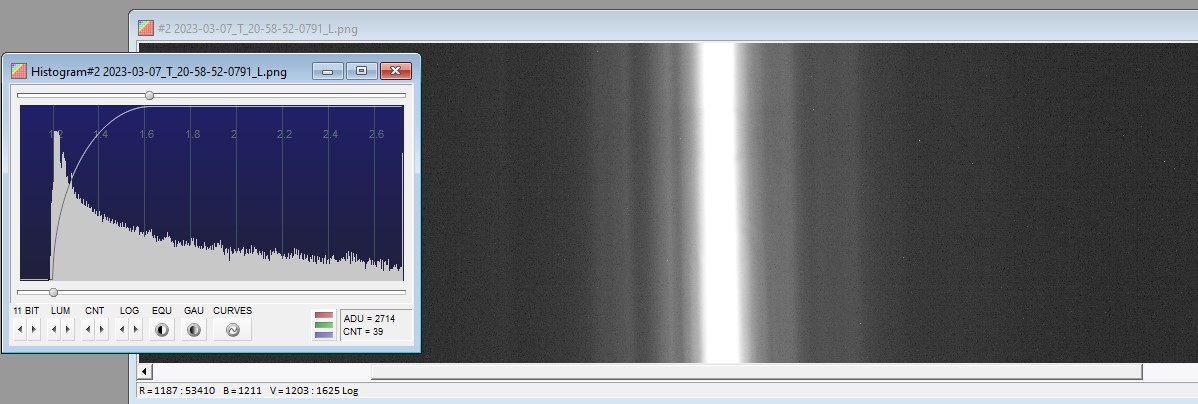
The amplitude of the inteference fringes is about 0.05% of the input signal:

2- ASI 432
Interference fringes develops just like with the ASI 290
3- Player One Saturn M (IMX 533)



Return to narrowband filters test
Return to solar page
Return
to home page




















